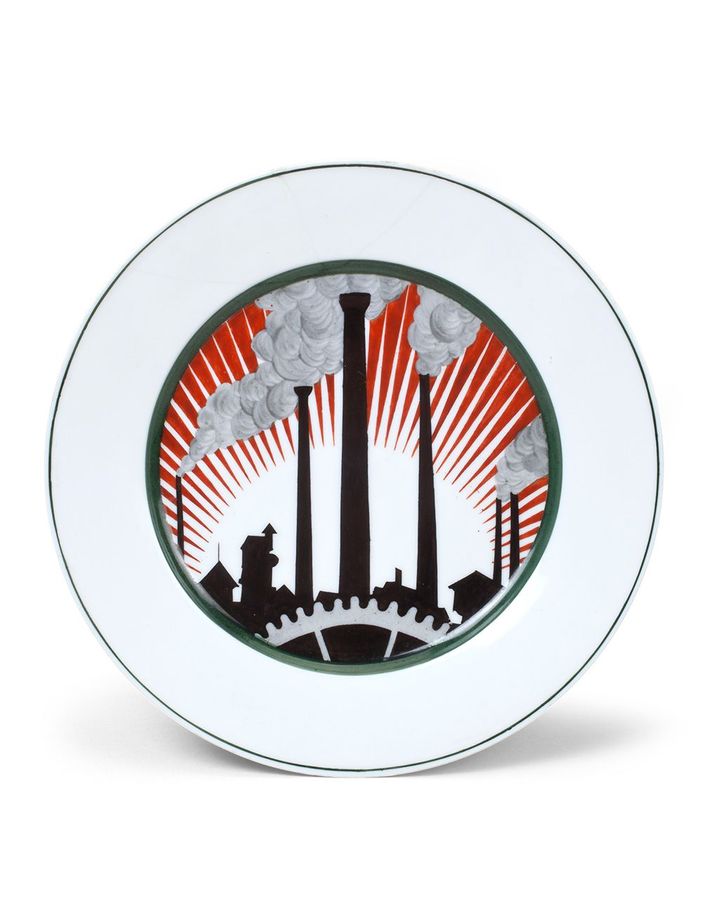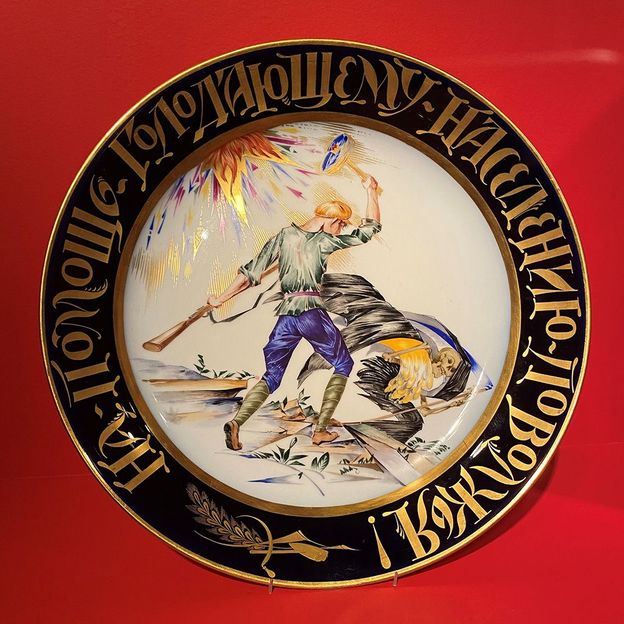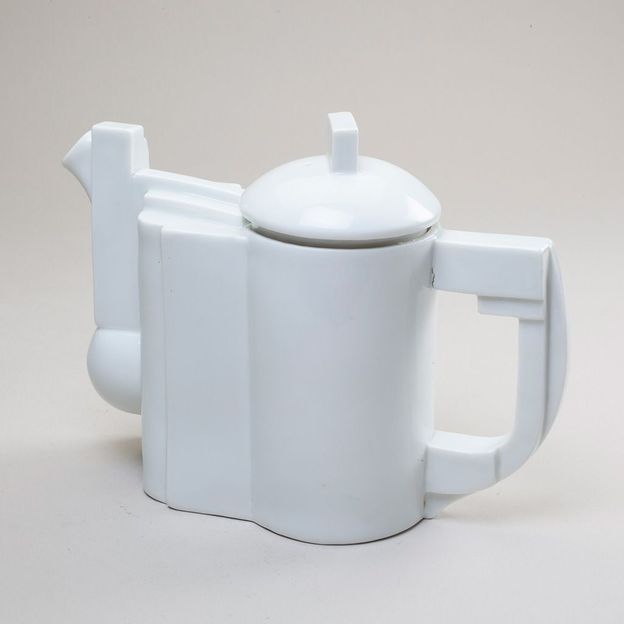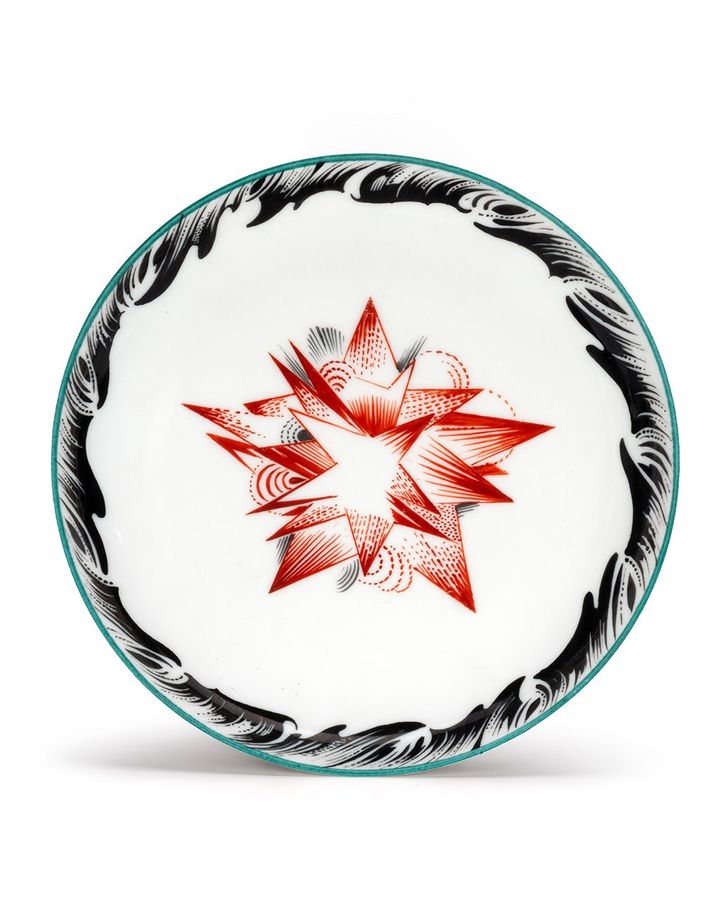How teapots spread Russian propaganda

It is 1917 and in Russia the Bolsheviks have seized power, de-throning the Tsar and declaring a revolutionary communist regime that would transfer the means of production to the people. Within a year, the royal family and their entourage lie dead as imperialism is violently dismantled to make way for Russia’s radical new future. But one important remnant of the old order remains: the Imperial Porcelain Manufactory (IPM) on the outskirts of the city now known as St Petersburg.
More like this:
– How a painting fought Fascism
– Can propaganda be great art?
– Why Orwell’s 1984 could be about now
Renaming it the State Porcelain Manufactory, the Bolsheviks, under Vladimir Lenin, took control of this symbol of tsarist decadence, seeing surprising potential in it as a wheelhouse for artistic innovation and the production of propaganda. Stocks of unpainted, snow-white china became a tantalising canvas for avant-garde artists keen to express their utopian ideologies and rouse enthusiasm for the new socialist era, giving this delicate, bourgeois material an unexpected, almost contradictory, second life.

Silhouette of factory chimneys, Nina Zander, 1919 (Credit: Hermitage Museum, Amsterdam)
The IMP hallmark was scratched out or painted over and replaced with a cog (denoting industry and the worker’s part of a greater whole) and a sickle and hammer, emblems that symbolised the union of worker and peasant and would feature on the Soviet Union’s flag. Under the direction of artist and ceramicist Sergei Chekhonin, the motif would be integrated into many of the factory’s designs, including his own. Increasing the country’s productivity was at the heart of Leninist ideology and so it was that on this re-imagined porcelain, bold images of smoking chimneys, telegraph wires and tower blocks took the place of the pastoral scenes and intricate gilded heraldry the factory was once known for. They appear in a book published to accompany the broadest exhibition of the revolutionary porcelain story ever staged outside Russia, Russian Avant-Garde – Revolution in the Arts, which opened at the Amsterdam branch of the Hermitage Museum in January, but closed when the Russian invasion of Ukraine led the museum to cut ties with St Petersburg.
Agitation porcelain, as it became known, featured effigies of Lenin and was decorated with calls to action. Its creators hoped to galvanise the proletariat, whose idealised hand-painted image also rolled off the − rather slow − production line. Emancipated workers now took centre stage, often as noble engines of industry, striding towards a radiant future, as seen in the plates of Mikhail Adamovich (1921) and Anton Komashka (1923), or peasants jubilantly taking up arms, as in Natalia Danko’s 1922 figurine.

‘Help the starving population along the Wolga’ dish, with the slogan ‘To benefit the starving’, Rudolph Wilde (words) and Alexander Kudriavtsev (painting), 1921
In a curious twist, crockery once intended for the lavish feasts of the Romanovs was now emblazoned with militant Reds trampling upon their white ermine furs (Adamovich, 1923). Danko’s porcelain chess set (1923) used the same colour play, with a red army taking on a white skeleton king whose proletariat pawns are in chains.
While the porcelain plates’ blocky constructivist artwork conveyed energy, explosions and destruction, the requisitioning of the factory was part of a softer approach to demonstrate the communists’ respect for Russian patrimony, and ingratiate the precarious new regime with the powerful upper-middle classes whose support they depended on in order to govern. ”The main reason for the Bolsheviks to maintain the porcelain factory was the preservation of cultural heritage,” historian and guest curator of the Hermitage exhibition, Dr Sjeng Scheijen, tells BBC Culture.
Cultural currency
The factory recruited the most visionary artists of their time, members of the Russian Avant-Garde such as Wassily Kandinsky and the suprematist Kazimir Malevich, whose abstract, geometric work – where feelings trumped figurativism – expressed a revolutionary artistic idiom that befitted the new regime. For the Avant-Garde, art had a role to play in every aspect of that new order, and they brought their unique style to diverse realms such as theatre, music, film and architecture. Ceramics were no different, and they were doubtless grateful for the regular income and prestigious connections the factory afforded during the harsh post-war period when famine, civil war and disease devastated so many Russian lives.

Teapot and lid, Kazimir Malevich, 1923 (Credit: Hermitage Museum, Amsterdam)
Above all, the artists were excited to experiment. ”Most of the time the artists were just looking at the forms and how they could integrate their own extremely revolutionary, abstract language that they had developed, into these particular forms,” says Scheijen. Alexander Samokhvalov’s The Seamstress (1923) is a case in point. He makes the plate’s circular shape part of the design, while the central composition, a dressmaker in her studio, echoes the geometric motifs of the plate’s decorative border. ”They were real, independent artworks,” adds Scheijen. ”If you only look at them from a utilitarian aspect, either as a [table] service or as a service to the state, you do them an injustice.”
The creations were indeed far from commercial. ”They were too rare, too experimental,” Birgit Boelens of the Hermitage Amsterdam tells BBC Culture. ”The individual pieces are of such a high quality that it took too long to mass produce them.” Sets such as Malevich’s half-moon cups and chunky teapots were too clumsy and outré for 1920s society and destined only for display, as were the hand-painted plates and jugs, whose delicate brushwork could not withstand regular use.
As a result, despite the porcelain’s revolutionary messages, the working people had very little contact with it, and for the most part it remained in the hands of wealthy collectors. Even the designs intended to raise money for the famine in the Volga region in the early 20s never made it to auction. Instead, pieces were showcased in European exhibitions, such as the 1925 Exposition Universelle in Paris, where Russian porcelain designers were awarded a gold medal. As models of artistic ingenuity, the pieces were extraordinary. As tools of propaganda, they were unavoidably flawed.
By the late 20s, when Joseph Stalin had ascended to power, rooted out all opposition and established a dictatorship, the use of art as a vehicle for propaganda only intensified, propping up a brutal regime with saccharine images of the leader surrounded by adoring children and merry communist youth brigades. Socialist realism was born, but it was inevitably inauthentic and prosaic. The requirement that all art be educational and popular had stifled artistic endeavour.

‘Red flag’ saucer, Rudolph Wilde (composition), Mikhail Peshcherov (painting), 1921 (Credit: Hermitage Museum, Amsterdam)
”Everything really changes in the beginning of the 30s when artists themselves come under real pressure because there is no independent artistry any more,” explains Scheijen. ”If you are not part of a union, you can be seen as a parasite and be sent to a camp… If you would not completely conform, then you had a big problem.” Art had lost its verve. “You see how a great artistic culture dies because of the pressure,” says Scheijen. ”When you go to the depositories of museums for the late 30s, it’s really depressing.”
Forced famine, mass incarceration and summary executions had left the utopian vision of 1917 in tatters. Socialism had failed and revolutionary art had done nothing to better the lives of the poor. For Boelens, the survival of these highly prized porcelain pieces and the fact that they are now enjoyed by so many is nevertheless testimony to the importance and success of their art. “We appreciate these pieces so much,” she says. ”The positive thing about this exhibition is we gave them, after all these years, a voice.”
“It was a unique phenomenon and so the fact that it happened gives us something to celebrate,” agrees Scheijen. ”Imagine if the Wedgewood factory employed Picasso, Matisse, Kandinsky and all the great modernists at the same time and let them do whatever they wanted? That’s an amazing thing, and it only happened there.”
The Hermitage Museum’s book Russian Avant-Garde – Revolution in the Arts is available for international order.
If you would like to comment on this story or anything else you have seen on BBC Culture, head over to our Facebook page or message us on Twitter.
And if you liked this story, sign up for the weekly bbc.com features newsletter, called The Essential List. A handpicked selection of stories from BBC Future, Culture, Worklife and Travel, delivered to your inbox every Friday.














